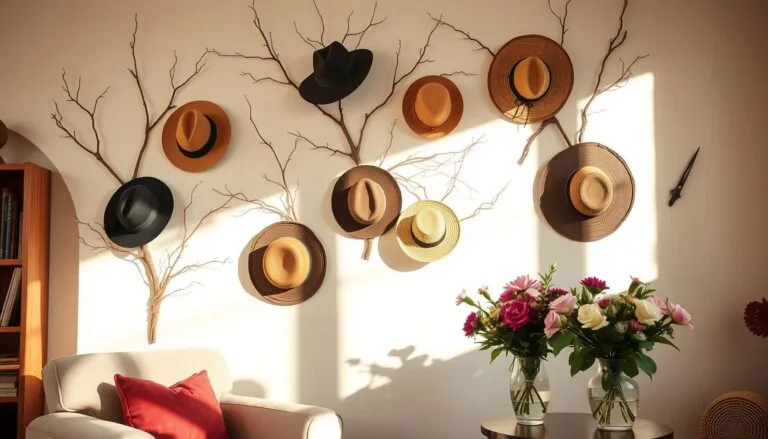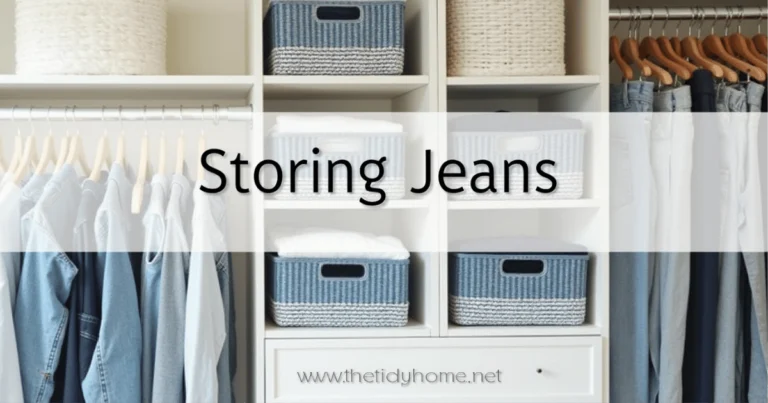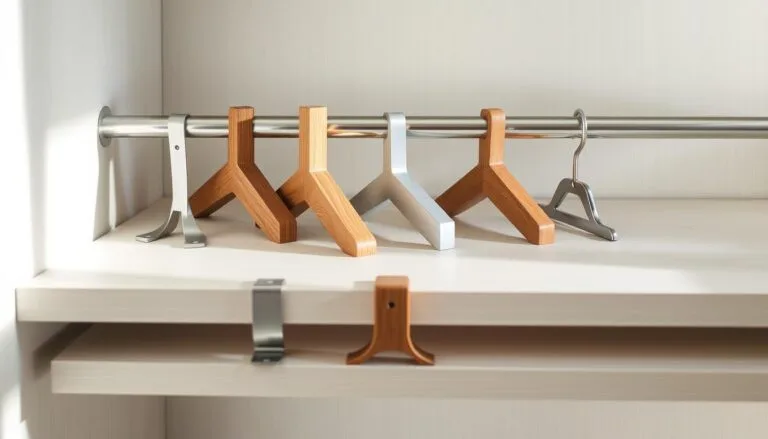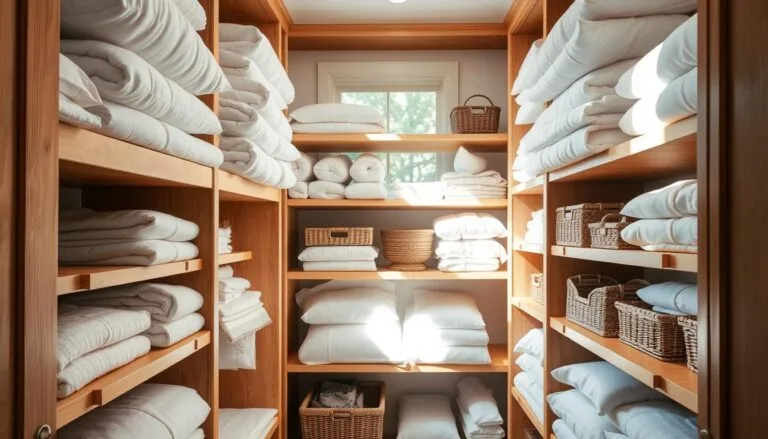How to Use Baby Closet Clothes Dividers for Easy Organization
Table of Contents
Every new parent faces the challenge of managing a growing baby wardrobe. Clothes multiply fast, and sizes change quickly. Baby closet clothes dividers are key to keeping things organized.
Imagine finding the perfect outfit for your baby without digging through piles. These tools make sorting and accessing clothes easy. They help keep your baby’s wardrobe tidy, from newborn to toddler sizes.
Managing infant clothes needs a plan. Size changes are common, and tracking what fits can be hard. Smart systems save time and reduce stress. Our guide will show you how to organize your baby’s closet.
Whether you’re a first-time parent or have multiple kids, organizing the nursery is crucial. These dividers make managing clothes easy and stress-free. They grow with your child, helping you stay organized.
Understanding Baby Closet Clothes Dividers: Essential Organization Tools
Keeping your baby’s clothes organized can be tough for new parents. Baby wardrobe organizers are a simple way to manage lots of tiny clothes. They help you set up a system that saves time and lowers stress.
Baby closet dividers come in many styles and designs. They are made to fit different needs. From hanging dividers to shelf separators, they turn messy spaces into tidy wardrobes.
Types of Closet Dividers Available
There are many types of baby closet dividers. Plastic dividers are durable and easy to clean. Cardboard dividers are light and cheap. Some have color-coded sections to sort clothes by size or season.
Benefits of Using Clothes Dividers
Using baby wardrobe organizers has many benefits. They help you find the right size clothes fast, saving time. They keep outfits organized and can grow with your child.
Materials and Durability Features
When picking baby closet dividers, think about the material and how long it lasts. Strong plastic dividers can handle a lot, while light materials make moving easy. Choose dividers with smooth edges and safe designs for the best results.
Getting Started: Preparing Your Baby’s Closet Space
Starting with a clean and organized closet is key. Begin by removing things you don’t need and check the space you have. Think about what clothes and accessories your baby really needs.
Clear out the closet completely. Get rid of adult clothes, extra storage, and anything not for your baby. Measure the closet to see how much you can store. Use hanging organizers, shelves, and small storage to make the most of the space.
Good lighting is important in a baby’s closet. Make sure it’s bright so you can find what you need. You might want to add battery-operated lights or a small overhead light. A white or neutral-colored closet also helps reflect light and makes the space feel bigger.
Consider setting up different zones in your closet. Have areas for everyday clothes, special outfits, and accessories. Choose storage that can change as your baby grows.
Don’t think you need to spend a lot on baby room storage. You can find affordable options like fabric organizers, stackable bins, and over-the-door systems. These can help keep your closet tidy without costing too much.
Selecting the Right Baby Closet Clothes Dividers for Your Needs
Organizing your baby’s clothes can be tough. Infant clothing organizers are key for parents wanting to keep their nursery tidy. The right dividers can turn a messy closet into a neat, growing space for your baby.
There are many options for clothes dividers. Each type has its own role in keeping your baby’s clothes organized and easy to find.
Size-Based Dividers
Size-based dividers sort clothes by size. They help you separate clothes for newborns, 0-3 months, 3-6 months, and bigger sizes. This makes it easy to find the right fit as your baby grows fast in the first year.
Age-Based Dividers
Age-based dividers track your baby’s growth stages. They organize clothes by age, making it simple to find the right outfits. These dividers are great for managing hand-me-downs or gifts from family.
Season-Based Dividers
For families with changing seasons, season-based dividers are essential. They separate summer, winter, spring, and fall clothes. This makes it easy to switch wardrobes and keep clothes suitable for the weather.
Choosing the right dividers depends on your style and needs. Try different systems to find what works best for your family.
Step-by-Step Guide to Installing Nursery Closet Dividers
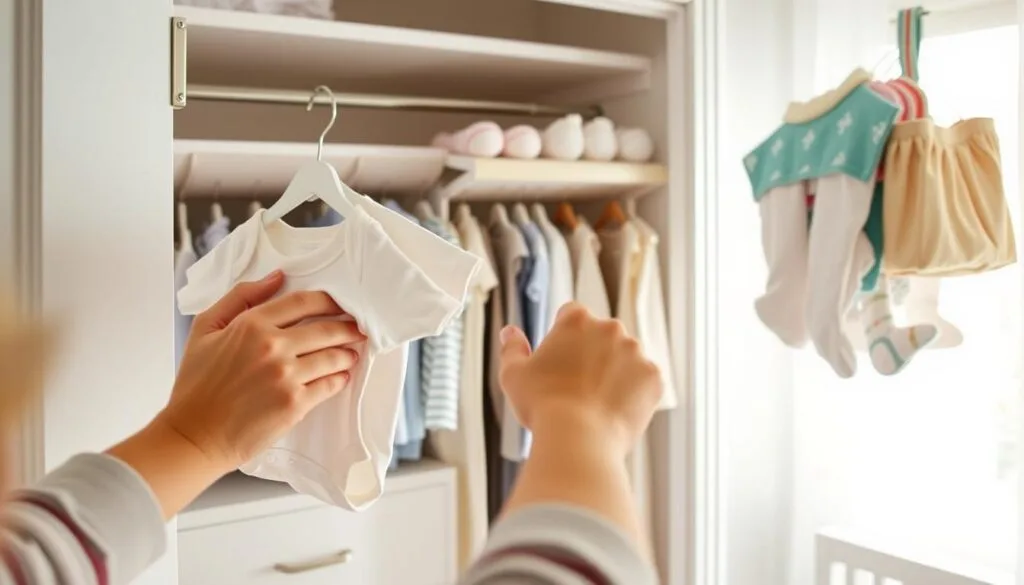
Setting up a baby clothes organizer is the first step to a tidy nursery. Closet dividers make sorting out your baby’s clothes easy and stress-free.
Start by clearing out your baby’s closet. Measure the rod and shelves carefully. Closet dividers fit standard rods and should match your nursery’s colors. Choose ones with clear labels.
Install vertical dividers evenly to see all your clothes. Space them so each section fits different sizes. Use color or labels to sort clothes by age or type.
For drawers, use stackable dividers for separate spots. They keep socks, onesies, and accessories tidy. Adjustable dividers grow with your baby’s clothes.
Pro tip: Label each divider with size or type. This makes picking outfits fast, even in the morning rush. Your baby clothes organizer is key to managing their growing wardrobe.
Organizing Baby Clothes by Size and Age Groups
Organizing your baby’s clothes can be tough. Baby closet clothes dividers are key for handling size changes. They help sort clothes from newborn to toddler.
Newborn to 24 Months Classification
Figuring out baby clothes sizes is hard. Sizes go from preemie to 24 months, with big differences between brands. Dividers let you sort clothes by age.
Pro tip: Make each size section a bit bigger. Babies grow differently, and sizes vary. Color-coded dividers make finding clothes easy.
Special Occasion Outfit Organization
Every parent wants to keep special outfits safe. Set aside a spot for holiday and formal clothes. Use soft dividers to keep fabrics safe and wrinkle-free.
Update your system as your baby grows. What fits a newborn won’t fit a toddler. Being flexible is important for managing clothes.
Seasonal Clothing Organization with Baby Wardrobe Organizers
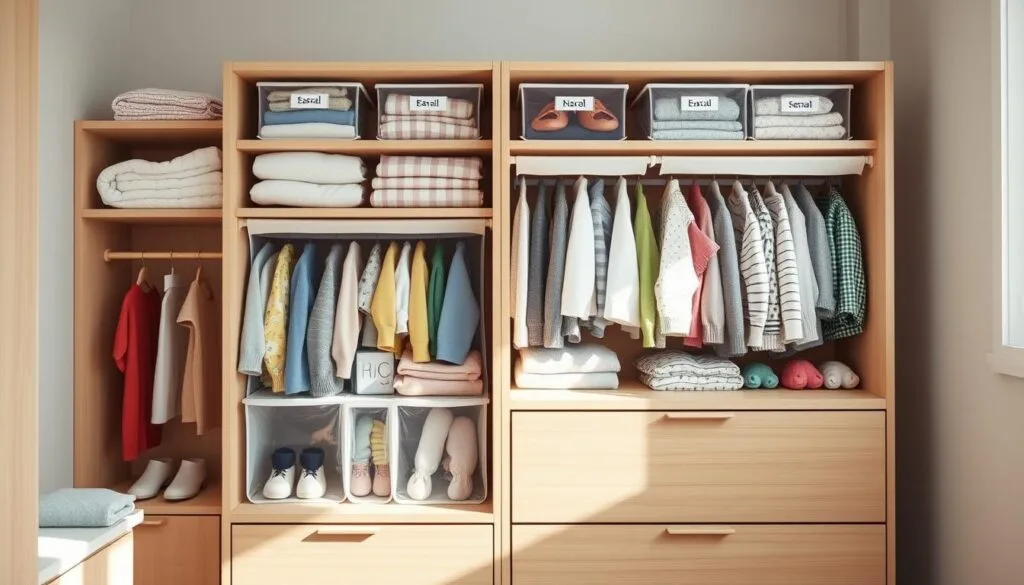
Organizing your baby’s clothes by season saves time and reduces stress. As your baby grows, their clothes sizes change fast. Smart organizers help manage these changes smoothly.
Begin by setting up separate storage areas for each season. Use clear plastic containers with tight lids to keep clothes dust-free. Vacuum bags are great for bulky winter items like coats and sweaters. Label each container with size and season for easy access later.
Think about a capsule wardrobe for your baby. Choose versatile pieces that can be mixed and matched. Opt for neutral colors and clothes that can be layered for different temperatures. Store outgrown clothes in breathable bags to avoid mildew.
Switch out clothes as the seasons change. Keep current season clothes easy to reach. Use hanging organizers with compartments to sort clothes by type and size. This makes it simple to find what you need without messing up the closet.
Don’t forget to check and update your baby’s wardrobe often. Babies grow fast, so clothes that fit today might be too small soon. Regular checks ensure your baby always has the right clothes.
Maximizing Storage Space with Infant Clothing Organizers
Creating an efficient nursery is all about smart storage. It’s important to use every inch of space. Without the right organizers, your baby’s clothes can quickly get out of hand.
Using vertical space can turn a messy nursery into a tidy haven. Think about adding hanging shelves that go from top to bottom. These organizers can hold folded clothes, blankets, and more, saving floor space.
Vertical Space Optimization Strategies
Make the most of your nursery’s space with multi-tier hangers and over-the-door organizers. These solutions add room for small items like socks and hair accessories. Pocket organizers on the door keep essentials within reach, keeping the closet neat.
Drawer Organization Techniques
Turn your drawers into storage zones with dividers and roll-folding. Use clear dividers to sort clothes by type or size. Roll clothes instead of folding to save space and reduce wrinkles.
These storage tips help create a space that grows with your baby. Remember, be flexible and update your system as your baby’s wardrobe changes.
Maintaining Your Baby Clothes Storage System
Keeping your baby clothes organizer in top shape is a job that needs ongoing effort. It’s not just a one-time setup. It’s a process that keeps evolving and needs regular care. Start by setting aside time each month to check your baby’s clothes. This ensures everything stays organized and clutter-free.
When you do these monthly checks, get rid of clothes that are too small. Reorganize your dividers to keep things tidy. Look for clothes that don’t fit anymore and set aside places for donations or future use. A quick 10-minute tidy each week can stop big messes from happening.
Make sure everyone helps keep the nursery organized. Create a simple guide that shows how to put clothes away. This way, everyone knows how to keep things organized, making the system work better.
When you get new clothes or gifts, add them to your system right away. Sort them by size and season using your dividers. This keeps clutter away and makes managing your baby’s clothes easier.
Remember, being flexible is important in organizing baby clothes. As your baby grows, you might need to change how you organize things. What works now might not work later, so be ready to make changes as needed.
Time-Saving Tips for Quick Baby Clothes Access
Managing a baby’s clothes can be tough. Smart parents make mornings easier with smart storage. Baby closet dividers are key to a quick and easy wardrobe.
Using smart dividers in the nursery makes finding clothes fast. Color coding is a great way to organize. It makes picking out clothes a breeze.
Mastering Color Coding Systems
Turn your baby’s closet into a colorful rainbow. Use blue for everyday clothes and pink for special occasions. Color-coded dividers help you find what you need fast.
Daily Outfit Planning Strategies
Plan outfits for the week ahead with dividers. Group clothes together for easy access. Choose comfy clothes for the day and keep sleepwear separate.
Pro tip: Place often-worn items where they’re easy to see. Switch out clothes with the seasons to keep your wardrobe fresh.
Creative Solutions for Small Nursery Closets
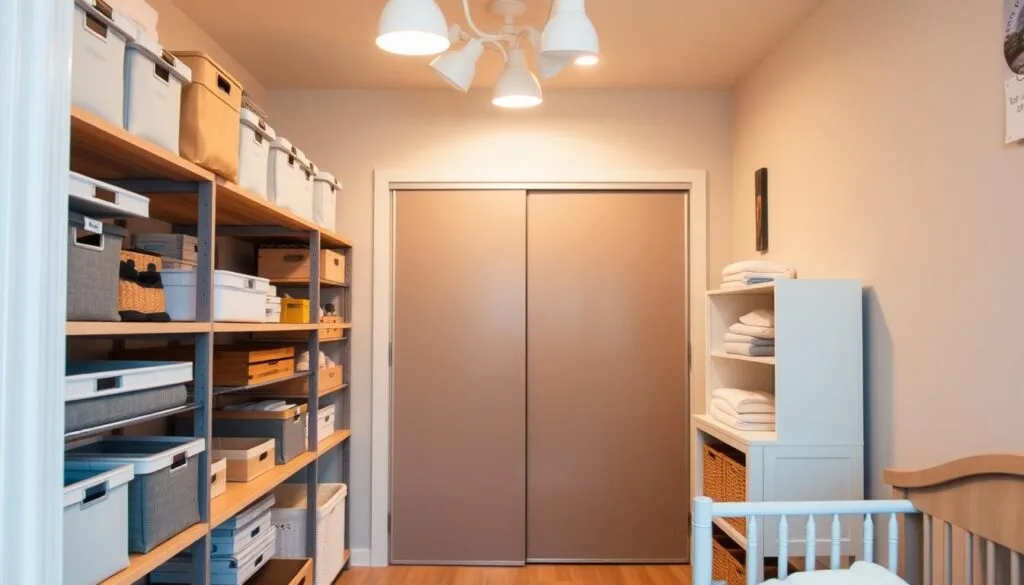
Having a small nursery closet doesn’t mean you’re stuck with mess. With smart storage, even tiny spaces can become organized. The trick is to use every inch of space.
Begin with baby clothes storage dividers to sort out your baby’s clothes. Choose slim, stackable organizers that save space. They should have hooks, shelves, or expandable parts for extra use.
Think outside the box with over-the-door organizers. They have clear pockets for easy access to clothes, accessories, and diapers. Wall shelves and corner units also add storage without taking up floor space.
Don’t forget about using other areas for storage. Cribs with drawers, changing tables with lots of space, and under-bed bins can help a lot. Pick items that do more than one thing.
Keep things simple in small areas. Check your baby’s clothes often and get rid of what’s too small or out of season. This keeps your storage tidy and clutter-free.
Professional Tips for Long-Term Closet Organization Success
Keeping your nursery closet organized is key. It needs careful planning and regular work. Your baby’s clothes will change a lot, so it’s important to have a good plan for organizing clothes and storage.
Organizing your baby’s closet doesn’t have to be hard. Small steps can make a big difference. They help manage clothes and use space well.
Creating a Maintenance Routine
Make a plan to check and organize your baby’s closet often. Set aside time each month to check sizes, get rid of old clothes, and update dividers. Using digital tools can help track sizes and inventory better.
Smart Storage Rotation Strategies
Use a seasonal rotation for your closet. Store clothes you don’t use now in labeled bins. Use vacuum-sealed bags for special outfits or future kids. This keeps your closet tidy and easy to manage.
As your child grows, you’ll need to change your organization plan. Choose dividers that can be easily changed to fit your child’s growth.
Storage Solutions for Growing Baby Wardrobes
As your baby grows, your storage needs change fast. Modular organizers are great because they grow with your child. Look for adjustable shelving and hanging systems that can change as your baby gets bigger.
Think about using “size-up” storage boxes for future clothes. Clear containers that stack are perfect for keeping track of clothes your baby will wear soon. Brands like Sterilite and SimpleHouseware have great options for keeping clothes organized.
Using hand-me-downs from siblings or relatives is smart. Label each box with size and season to keep things organized. This saves money and keeps your closet tidy, ready for your child’s growth spurts.
Getting ready for your baby’s growing wardrobe means planning ahead. Choose storage that can grow with your child, like adjustable rods and shelves. Your storage should be as flexible as your baby’s needs, keeping you ahead in managing their clothes.
Tell Us What You Think: Your Input Matters
There are no reviews yet. Be the first one to write one.



